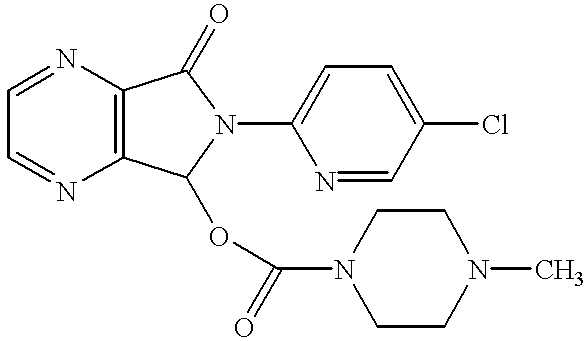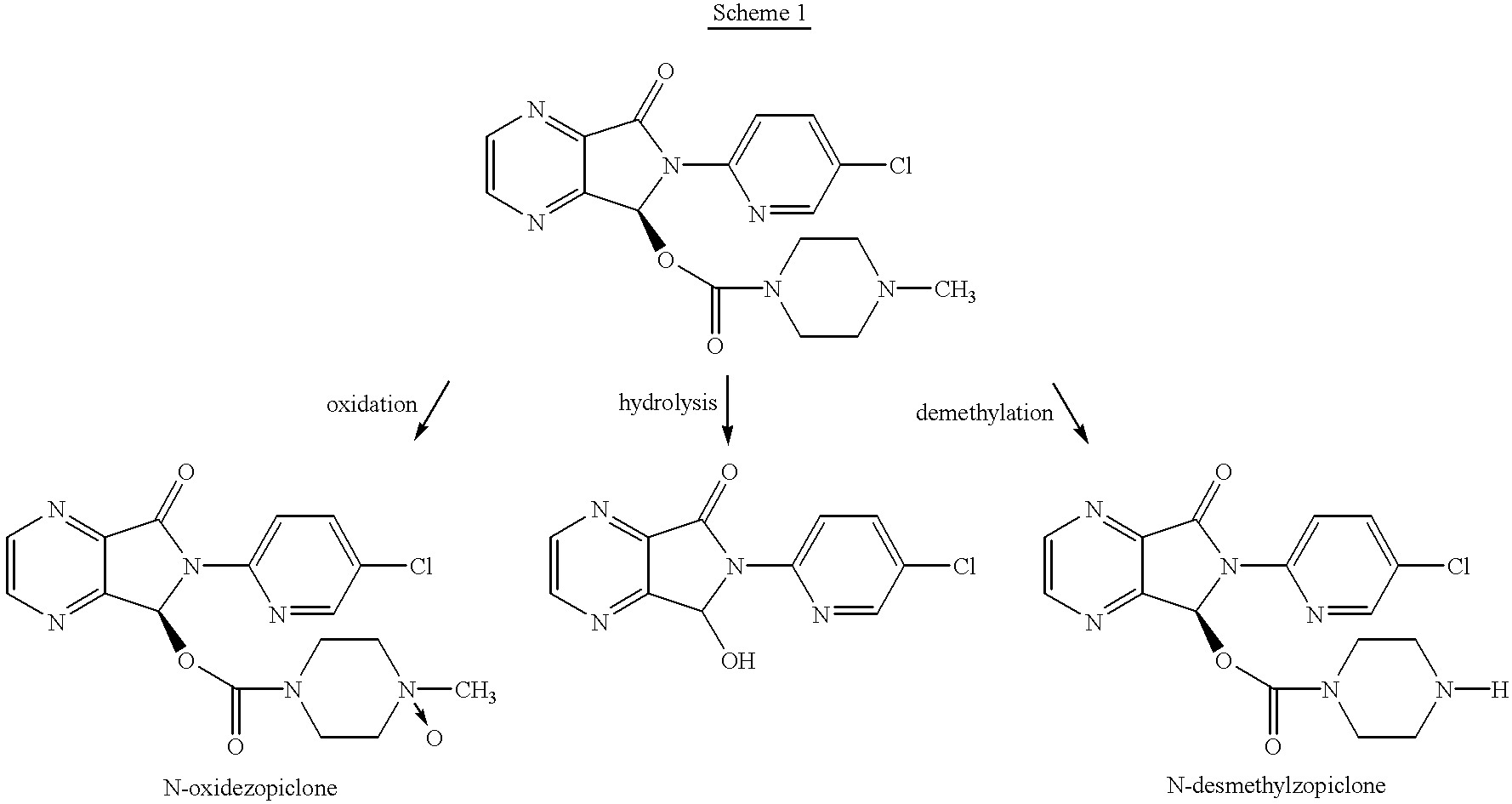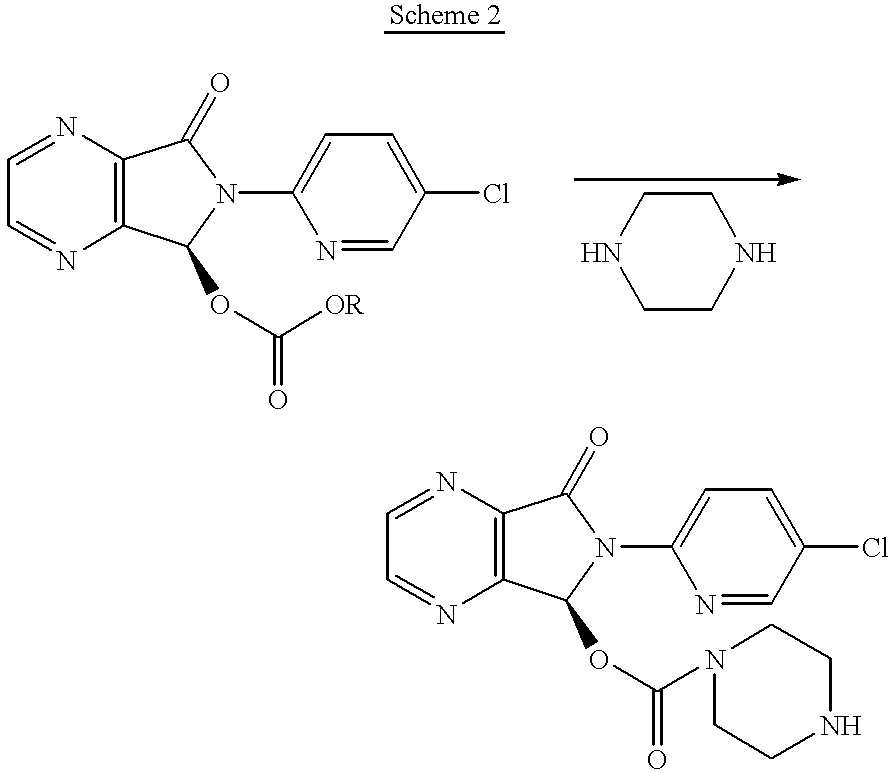Methods of making and using N-desmethylzopiclone
a technology of zopiclone and n-desmethylzopiclone, which is applied in the field of making and using n-desmethylzopiclone, can solve the problems of rapid and complex metabolism of zopiclone, adverse effects, and muscarinic agonists
- Summary
- Abstract
- Description
- Claims
- Application Information
AI Technical Summary
Benefits of technology
Problems solved by technology
Method used
Image
Examples
example 1
Synthesis of (.+-.)-N-desmethylzopiclone
To a solution of (.+-.)zopiclone (6.2 g, 20 mmol) in toluene (120 ml) was added diethyl azodicarboxylate (DEAD, 8.2 g, 50.0 mmol) and the solution was stirred at 60.degree. C. for 26 hours. The solvent was removed under reduced pressure. The residue was added to 60 ml of EtOH / NH.sub.4 Cl aq (1:1) and the resulting mixture was refluxed for 4 hours. The reaction mixture was concentrated to remove ethanol under reduced pressure and the residue was partitioned by adding saturated NaHCO.sub.3 solution and CH.sub.2 Cl.sub.2 (100 ml). The organic phase was then separated and washed with water (30 ml), brine (30 ml), and dried over Na.sub.2 SO.sub.4. The crude product was loaded onto a silica gel column and eluted with CH.sub.3 CN:MeOH:NH.sub.4 OH (25:4:1) to give 1.56 g of product with chemical purity of approximately 91% (25% yield). A second flash chromatography yielded (+)-N-desmethylzopiclone with >98% chemical purity. .sup.1 H NMR (CDCI.sub.3), ...
example 2
Synthesis of (+)-zopiclone
(a) Preparation of (+)-zopiclone-D-malate Salt
A three-neck 2.0 L flask was charged with (.+-.)-zopiclone (40 g, 0.101 mol, 1.0 eq), D-malic acid (13.4 g, 0.97 eq.), 406 mL MeOH and 754 mL acetone. The reaction mixture was heated in an oil bath to 55-56.degree. C. for about 30 min and gradually cooled to 45-47.degree. C. over approximately 30 min. (+)-zopiclone-D-malate seeds (0.1 g, 0.02%) was added at 45-47.degree. C. The reaction mixture was cooled to 40.degree. C. over 1 h and then cooled to 10-15.degree. C. over 3 h. Then the slurry was held at 10-15.degree. C. for 30 min. The solid product was isolated by filtration and washed with cold MeOH (2.times.50 mL, 0-5.degree. C.). The white product was dried at 30-40.degree. C. / 28 mmHg over 6-12 h to give (+)-Zopiclone-D-malate (22.6 g, 42%, 96.5% ee).
(b) Preparation of (+)-zopiclone
A three-neck 250 mL flask was charged with (+)-zopiclone-D-malate (10 g, 93% ee), 20 mL water and 150 mL of EtOAc. The reaction ...
example 3
Synthesis of (+)-N-desmethylzopiclone
To a solution of (+)-zopiclone (4.0 g, 10.3 mmol) in toluene (100 ml) was added DEAD (5.4 g, 30.0 mmol) and the solution was stirred at 55.degree. C. for 40 hours. The solvent was removed under reduced pressure and the residue was added 60 ml of EtOH / NH.sub.4 Cl aq (1:1) and the resulting mixture was refluxed for 4 hours. The reaction mixture was concentrated under reduced pressure to remove the ethanol and the residue was partitioned by adding saturated NaHCO.sub.3 solution and CH.sub.2 Cl.sub.2 (100 ml). The organic phase was then washed with water (30 ml), brine (30 ml), and dried over Na.sub.2 SO.sub.4. The crude product was loaded onto a silica gel column and eluted with CH.sub.3 CN:MeOH:NH.sub.4 OH (25:4:1) to give 1.25 g of the product with chemical purity of ca 90% (27% yield). A second flash chromatography yielded (+)-N-desmethylzopiclone with >97% chemical purity and >99% ee by chiral HPLC: Chiralcel OD, mobile phase: Hexane:Ethanol:Met...
PUM
| Property | Measurement | Unit |
|---|---|---|
| Percent by mass | aaaaa | aaaaa |
| Percent by mass | aaaaa | aaaaa |
| Percent by mass | aaaaa | aaaaa |
Abstract
Description
Claims
Application Information
 Login to View More
Login to View More - R&D
- Intellectual Property
- Life Sciences
- Materials
- Tech Scout
- Unparalleled Data Quality
- Higher Quality Content
- 60% Fewer Hallucinations
Browse by: Latest US Patents, China's latest patents, Technical Efficacy Thesaurus, Application Domain, Technology Topic, Popular Technical Reports.
© 2025 PatSnap. All rights reserved.Legal|Privacy policy|Modern Slavery Act Transparency Statement|Sitemap|About US| Contact US: help@patsnap.com



